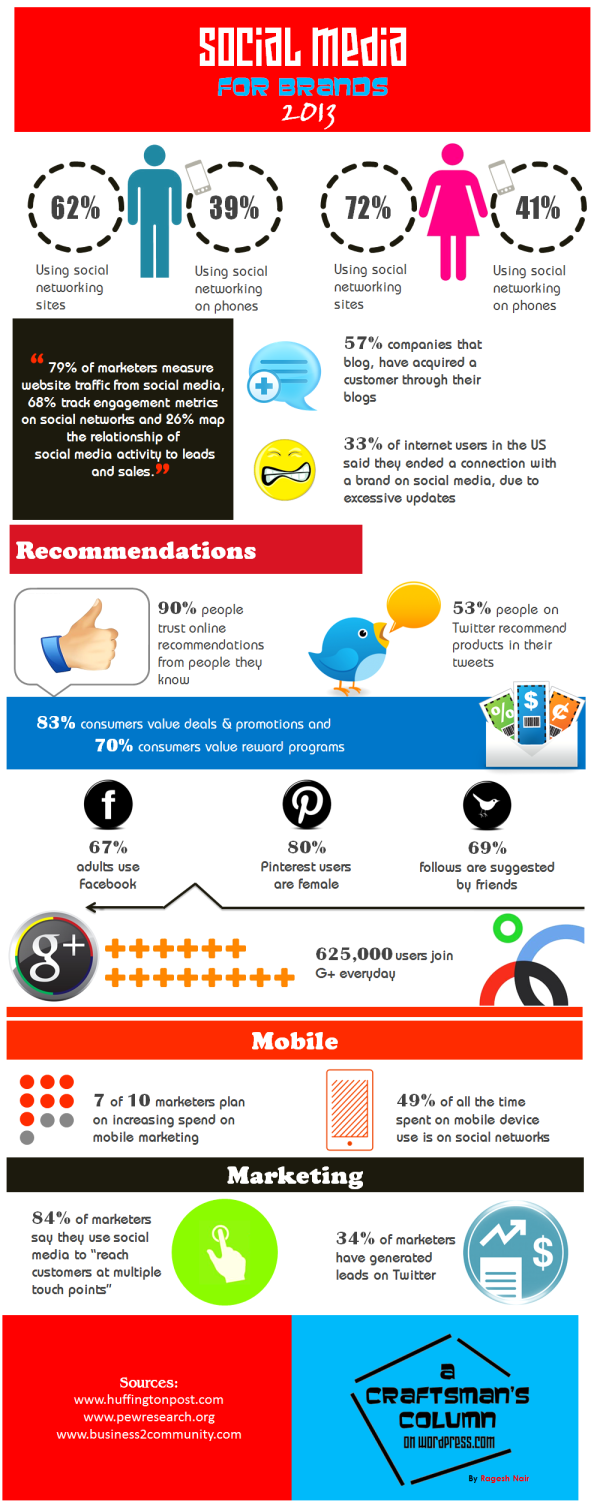So here we’re, in the year 2013. The good news is that the ‘bubble’ we’ve all come to know as social media is still intact! In fact, it’s soaring. With a spurt in internet and smartphone penetration over the past few years, more users are connected through social media today than what most of us would’ve expected until sometime back. Social has become one of the top buzzwords today – in schools/colleges, conference/board rooms, brainstorming sessions and even in our very own homes. It’s transforming the way we communicate, collaborate, entertain and consume/share information. The ‘what’ has already been addressed, the ‘why’ and ‘when’ is inessential, what we really need to now focus on is the ‘how’. How are we going to leverage social media to improve how individuals connect to one another and how brands connect with customers? Because at the end of the day, isn’t that what social media is all about?
Let’s take a crack at the second part of the ‘How’, shall we?
So, almost every brand has its presence established on one or more social networks. They’ve a good following, a decent content strategy and a few resources in place to manage all of this. Great. So now what? I bet most of the social media marketers still struggle to create a dashboard for their senior stakeholders, not knowing what they’re trying to present exactly. It’s not their fault really if the big bosses demand to see the ROI! However, mature organizations (on social media) have now realized that measuring ROI from social media is no mean task and in the meanwhile they have shifted their focus to activities that will help set the foundation, like managing online brand reputation, customer support and product/service marketing. Build the foundation right and everything else will fall into place.
While brands still grapple with the overwhelming possibilities of using social media, the modern day customer has become more powerful than ever before. She spends an average of 4 hours on social media every day, to catch-up with her friends, chat with her outstation aunt, check-in to her favorite places, post pictures from last weekend’s party, read reviews about a new movie, play a multiplayer game with her online friends, seek customer support, stay updated on current affairs and to research – consume information. So what does this mean for brands? Let’s try and understand this by bucketing a few of the factors into opportunities and challenges.
Challenges
Multiple stakeholders, multiple needs
A trend that one gets to see more and more in larger organizations these days is that various stakeholders within the organization like PR, Marketing, HR, Customer Service etc. work in silos to manage their own requirements, and there’s no cross-leverage of information or best practices. This leads to inconsistent messaging being sent out to the fans and followers of the brand.
First of all, it’s imperative that one team within the company owns social media and this team should ideally be marketing. Secondly, all the social media operations must be run by a central team which stakeholders have access to all the time. This team would be responsible for publishing content, responding to user queries and reporting. This is easier said than done, but it’s definitely worth the trouble considering how many social disasters you would manage to avert.

Negative Sentiment
Irrespective of whether the brand has presence on social media or not, customers are talking about it. The customer is more pragmatic and vocal today. She understands that she’s in a position to influence the sentiment of her peers towards a particular brand or product. Because of which she refuses to go through infinite loops and contact centers to have her grievance addressed. She no longer just expects service, she demands it. Every comment/post she publishes on social media has the ability to shape people’s sentiment towards your brand.
In such a scenario, it becomes crucial for large organizations, especially product companies, to establish a social contact center. Your 2-3 man social media team may be good enough to manage your presence and grievance desk, however, when you’ve thousands of customers interacting with your brand every day, you need to have several qualified agents responding to user grievances and bringing it to a closure. Swift responses will also result in the brand being acknowledged as genial and approachable.
Social contact centers, just like traditional call/data centers need to function 24/7 and if required, it must have multilingual capabilities.

Measure ROI
Like I mentioned earlier, ROI is not something that brands need to worry about at this stage in the social media evolution curve. However, it’s understandable that for any organization to make investments in social media, it needs to turn up some tangible results.
Essentially, ROI from social media = Investment made – revenue generated, right? So with this in mind, there are a few things that you could do to track social media enabled sales, especially if you’re a B2C company. You could add a field on your website asking customers how they heard about you and social media needs to be one of the drop-down options. You can track all the links that you publish on social media using bit.ly and map that against the activity on your website using any of the web analytics tools. You can also publish exclusive coupons through your social channels and use the coupon codes to track if a purchase was made.

Opportunities
Social Insights
Social media is a goldmine if you’re looking to profile your customers. You could even build a database of past and current customers and map their social accounts against their profiles. This would help you to tailor your customer’s experience while interacting with your brand. Not just this, the more acumen you build about your customers, the more likely it is that the customer would appreciate the interpersonal touch and would remain loyal to your brand. It’s also important to keep in mind that if you don’t do this, your competitors could run off with whole goddamn cake!
Profiling is not the only thing that you can do with a dump of your social data. You could further refine the data and use it to create insights and market intelligence. Marketers then need to go back to the strategy board and make iterations in real-time based on these insights. This would enable the brand to stay ahead of the curve and it would also have a direct bearing on customer satisfaction and revenue.

Creating Advocates
Brands have the opportunity to proliferate their brand messaging and to convert sentiments by tapping into influencer networks. Let me try and simplify this. Say, you have a customer who tweets a positive feedback about your product/service and people from their network echo their sentiment by means of retweets and replies, which means that the reach of the positive sentiment has multiplied. Another opportunity to get this to work to your advantage is to convert influential people into advocates for your brand.
Advocates are crucial to creating and sustaining a loyal follower base online. While choosing advocates for your brand, there are various specifics to consider, like their influence, their following, their allegiance to other brands, their profession, their online persona etc. Advocacy programs are essential to manage advocates. These programs need to be implemented with a long term view of how the advocates can be kept loyal to the brand, taking their best interests into account as well.

Proactive Selling
This is another way in which you can ensure higher ROI. However, proactive selling can have a negative impact on your brand if you approach it the wrong way. Also smaller companies with a low presence shouldn’t ideally be trying this. Brands like Dell and Wal-Mart have been successfully managing to do this for some time now.
So how do you sell proactively? Let’s assume you’re a cellphone manufacturer. A user sends a tweet saying “Aarggh. I’ve had enough. Trashing this junk and buying a new phone. Howz XYZ?” You should set-up keywords like “phone”, “mobile”,” buy”, yours and your competitors’ product names etc. on your social media monitoring tool. The moment somebody expresses interest to buy a new phone in your region/geo, your agents should reply to the user with information on your products, closest stores to buy from, links to customer reviews etc. If approached prudently, proactive selling holds the potential to boost your sales substantially.
Those were just a few of the areas where brands could capitalize on using social media. There are multiple such opportunities that social media presents us with today, we just need to know where to look.

Forecast for 2013
So what does 2013 hold in store for us? Following are a few changes/developments that I expect to see:
- The no. of users using Facebook on smartphones will overtake the no. of Facebook’s web users.
- Most television studios and production houses will turn to the social TV analytics folks, Bluefin Labs (acquired by Twitter), for generating actionable insights.
- More government organizations and political figures will take to Twitter for reputation management and for election campaigning.
- Despite their recent tie-ups with Visa and MasterCard, Foursquare will continue to fall off people’s radar, leading to the company being acquired by Twitter or Google.
- Facebook could make more changes to its UI, making it more advertiser-friendly. Facebook may close the acquisition of Microsoft’s Atlas Advertiser Suite by the end of the first quarter. This acquisition will allow Facebook to offer its advertisers enhanced analytics and targeting capabilities.
- More brands and celebrities will take to Google+ this year. Google hangout and communities will be extensively used by organizations and individuals alike.
- Gamification will be the game changer for e-commerce companies. More brands will look to integrate their loyalty and rewards programs with social media.
- Flipboard and Vine will gain in popularity. Instagram will continue to grow. Pinterest could see a slump in growth.
- More consumer brands will start offering customer service through social media and will have dedicated social contact centers.
At the beginning of this post, I referred to social media as a bubble and there’s a reason to it. Off-late a lot of the so-called internet ‘gurus’ have speculated on how the social media bubble has popped and they have even gone on to compare it with how the dot-com bubble had gone bust. A piece of advice to people who get influenced reading such articles – These gurus attribute the burst of a bubble to the fall in the rapid growth of a particular sector or crashing stock prices of a few players within sector. To my mind, that’s absolutely ridiculous. Just think about it, hasn’t e-commerce flourished even after the dot-com era? Aren’t domains and servers still selling like hot cakes? Aren’t people still investing in web technologies? Quite obviously, you can’t expect a sector to grow at the same pace as when it first came into being. Social media is a byproduct of the dot-com boom, it wasn’t a breakthrough trend. It has just reinforced what we already knew was going to be possible using the internet one day. Let me assure you, the media might change, but the social will always be there.
Let me leave you with the following infographic with some of the key trends for brands in social media.


Great thoughts, all are covered in single post. Excellent infographics included in the post. A good post for all the readers.
LikeLike